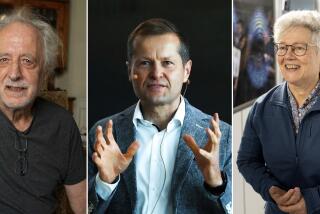Physicist Uses Laser Brakes to Slow Atoms for Study
- Share via
STORRS, Conn. — A physicist who uses lasers to slow atoms down to a fast walk says the project could help astronomers, improve navigation systems and lead to the rocket engines of science fiction--and it’s fun too.
Phillip L. Gould is building a laboratory at the University of Connecticut where he expects to use lasers like those in compact disc players to slow atoms from about 1,000 meters a second to 1 meter a second, slow enough to study.
Gould, 30, and associate professor Juha Javanainen plan to use cheap diode lasers to trap atoms from rubidium, a metal that vaporizes when heated.
The physicist’s work while a postdoctoral fellow at the National Bureau of Standards in Gaithersburg, Md., led to a Presidential Young Investigator Award from the National Science Foundation last spring.
In Gould’s experiments, the rubidium gas will be stored in a sealed container with a small hole that can emit rubidium atoms. To eliminate interference from other atoms, the rubidium atoms will be released into a vacuum inside a container roughly the size of a bread box.
When the atoms are released in this fashion, they travel in straight lines, making them relatively easy targets for a laser directed at the release area.
Lasers, like all light, exert a force in a steady stream of photons, or particles. When directed at the right frequency at a stream of atoms, the much lighter photons can eventually slow the atoms. Gould said it’s like slowing a bowling ball with Ping-Pong balls. Eventually, if enough Ping-Pong balls are thrown at the bowling ball, it will work.
The laser slows the atoms enough so six other lasers can be aimed at the spot where the atoms gather. This creates a viscous force, known as “optical molasses.” Once slowed, the atoms can be snared in a “laser trap,” which is sprung by bringing in even more lasers to encircle the atoms, Gould said.
The entire process, from release of the atoms until their entrapment, takes about 10 milliseconds. The result is that about 10 million atoms are caught in a “molasses” sphere about 1 centimeter across. The trap itself is even smaller, about 0.2 millimeter in diameter and containing 10,000 atoms.
Because the atoms are slowed, their temperature drops, falling to about 1 millikelvin, or just 0.001 Celsius degrees above absolute zero. Absolute zero is about minus-273 degrees Celsius, the point of no molecular motion.
The atoms can be observed by scientists because, when struck by the laser, they absorb and re-emit light, Gould said. “What I’m looking for is to compress the atoms, to get them to a fairly high density.
“I watch how they collide so I can learn about properties of atoms.
“I can’t foresee any project--making a better radio or anything like that. It’s esoteric stuff, but it’s fun. We find it very interesting.”
Everything in the universe is composed of atoms, and the research is aimed at providing a rare glimpse of the movements and interactions of these building blocks. It could lead to more precise measurement by atomic clocks, which are important for navigation and missile-guidance systems, and to the trapping of antimatter and improved spectroscopy, which is useful in astronomy.
Aside from improving atomic measurements, Gould said his research might someday be applied to capturing antimatter--an “off-the-wall” prospect but still a possibility. If hydrogen matter and antimatter could be snared in laser traps, they could be mixed in a controlled fashion, leading to a violent reaction useful for such things as propulsion systems for rockets.
“That’s one potential application down the road,” he said. “Who knows if it’s ever going to happen?”




